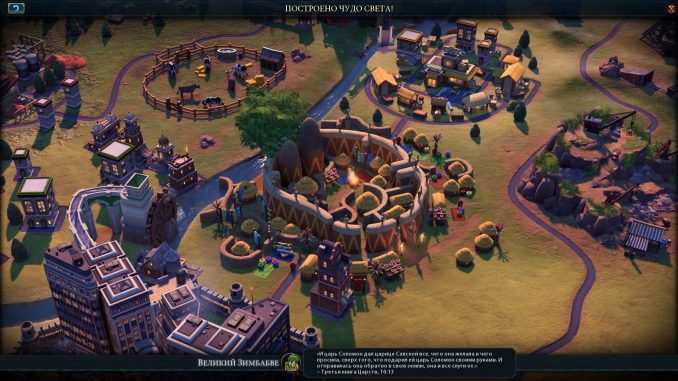
Introduction
Following this guide requires the Gathering Storm expansion.
It also assumes you have all other Civ 6 content, listed below, though it is not necessary to have these to utilise the key strategies of each civ.
- Pre-Rise and Fall content packs
- Vikings, Poland, Australia, Persia/Macedon, Nubia, Khmer/Indonesia
- Rise and Fall Expansion
- New Frontier content packs
- Maya/Grand Colombia, Ethiopia, Byzantium/Gauls, Babylon, Vietnam/Kublai Khan, Portugal
These content packs include exclusive civs, city-states, districts, buildings, wonders, natural wonders, resources, and a disaster, but not core game mechanics – all you need is the base game and the Gathering Storm expansion for those.
Persona Packs will not be covered until enough Civ players have access to them, as they would complicate the guides to America and France.
Once we realised no city could best the glory of Rome, we modelled the empire upon it. All our roads would lead to our great capital, and even the smallest of our cities commemorated our glory with great monuments. We brought civilization to a heathen world – aqueducts, baths, fora and insulae. And through our standardisation, we created the greatest fighting force our world has ever known – the Legion. Now, none may challenge our might save the gods themselves.
How to use this guide
This guide is divided into multiple sections explaining how best to use and play against this specific civ.
- The Outline details the mechanics of how the civilization’s unique features work and what their start bias is if they have one.
- The Victory Skew section describes to what extent the civ (and its individual leaders where applicable) is inclined towards particular victory routes. This is not a rating of its power, but an indicator of the most appropriate route to victory.
- Multiple sections for Uniques explain in detail how to use each special bonus of the civilization.
- Administration describes some of the most synergistic governments, government buildings, policy cards, age bonuses, pantheons, religious beliefs, wonders, city-states and Great People for the civ. Only the ones with the most synergy with the civ’s uniques are mentioned – these are not necessarily the “best” choices when playing as the civ for a given victory route.
- Finally, the Counter-Strategies discusses how best to play against the civ, including a consideration of leader agendas if the civ is controlled by a computer.
Note that all costs (production, science, etc.) mentioned within the guide assume a game played on the normal speed settings. To modify these values for other game speeds:
- Online: Divide by 2
- Quick: Divide by 1.5
- Epic: Multiply by 1.5
- Marathon: Multiply by 3
Glossary
Terminology used in this guide and not in-game is explained here.
AoE (Area of Effect) – Bonuses or penalties that affect multiple tiles in a set radius. Positive examples include Factories (which offer production to cities within a 6 tile radius unless they’re within range of another building of the same type) and a negative example is nuclear weapons, which cause devastation over a wide radius.
Beelining – Obtaining a technology or civic quickly by only researching it and its prerequisites. Some deviation is allowed in the event that taking a technology or civic off the main track provides some kind of advantage that makes up for that (either a source of extra science/culture or access to something necessary for a eureka or inspiration boost)
CA (Civ Ability) – The unique ability of a civilization, shared by all its leaders.
Compact empires – Civs with cities close together (typically 3-4 tile gaps between city centres). This is useful if you want to make use of districts that gain adjacency bonuses from other districts, or to maximise the potential of area-of-effect bonuses later in the game.
Dispersed empires – Civs with cities that are spread out (typically 5-6 tile gaps between city centres). Civs with unique tile improvements generally favour a more dispersed empire in order to make use of them, as do civs focused on wonder construction.
GWAM – Collective name for Great Writers, Artists and Musicians. All of them can produce Great Works that offer tourism and culture, making them important to anyone seeking a cultural victory.
LA (Leader Ability) – The unique ability of a specific leader. Usually but not always, they tend to be more specific in scope than civ abilities. Some leader abilities come with an associated unique unit or infrastucture.
Prebuilding – Training a unit with the intention of upgrading it to a desired unit later. An example is building Slingers and upgrading them once Archery is unlocked.
Sniping – Targeting a specific city for capture directly, ignoring other enemy cities along the way. Typically used in the context of “capital sniping” – taking a civ’s original capital as quickly as possible to contribute towards domination victory without leading to a drawn-out war.
Start bias – The kind of terrain, terrain feature or resource a civilization is more likely to start near. This is typically used for civilizations that have early bonuses dependent on a particular terrain type. There are five tiers of start bias; civs with a tier 1 start bias are placed before civs of tier 2 and so on, increasing their odds of receiving a favourable starting location.
Complete information on start biases within the game can be found in the Civilizations.xml file (find the Civ 6 folder in Steam’s program files, then go through the Base, Assets, Gameplay and Data folders to find the file). DLC and Expansion civs have a similarly-named file in their corresponding folders.
Super-uniques – Unique units that do not replace any others. Examples include India’s Varu and Mongolia’s Keshigs.
Tall empires – Empires that emphasise city development over expansion, usually resulting in fewer, but bigger, cities.
Uniques – Collective name for civ abilities, leader abilities, unique units, unique buildings, unique districts and unique improvements.
UA (Unique Ability) – A collective name for leader abilities and civ abilities.
UB (Unique Building) – A special building which may only be constructed in the cities of a single civilization, which replaces a normal building and offers a special advantage on top.
UD (Unique District) – A special district which may only be constructed in the cities of a single civilization, which replaces a normal district, costs half as much to build and offers some unique advantages on top.
UI (Unique Improvement) – A special improvement that can only be built by the Builders of a single civilization. “UI” always refers to unique improvements in my guides and not to “user interface” or “unique infrastructure”.
UU (Unique Unit) – A special unit that may only be trained by a single civilization, and in some cases only when that civilization is led by a specific leader.
Wide empires – Empires that emphasise expansion over city development, usually resulting in more, but smaller, cities.
Outline (Part 1/2)
Start Bias
Rome has no start bias.
Civilization Ability:All Roads Lead to Rome
- All owned cities start with a Trading Post, removing the usual requirement to complete a trade route to the city first.
- Founding or capturing cities within trading range of your capital automatically generates a road to it.
Trajan’s Leader Ability:Trajan’s Column
- All cities you found receive a free building:
- In ancient or classical era starts, the free building will be a Monument.
- In medieval era starts, the free building will be a Granary.
- In renaissance or industrial era starts, the free building will be a Water Mill for cities adjacent to a river, or Medieval Walls otherwise.
- In modern or atomic era starts, the free building will be a Water Mill for cities adjacent to a river, or a Sewer otherwise.
- In information era starts, the free building will be a Water Mill for cities adjacent to a river, or a Flood Barrier in a non-riverside coastal city. Cities on neither a river nor a coast will not receive any free buildings.
Unique Unit:Legion
A classical-era melee infantry unit which replaces the Swordsman
| Research | Obsoletion | Upgrades from | Upgrades to | Cost | Resource | Maintenance |

Iron Working |

Gunpowder** |

Warrior 1. |

Musketman 2. |
110 or or |
10 |
2 |
*Purchasing units with faith requires the Grand Master’s Chapel government building, which requires either the medieval-era Divine Right or renaissance-era Exploration civics.
**If you have insufficient nitre, you may continue to train Legions even after researching Gunpowder.
| Strength | Ranged Strength | Moves | Range | Sight | Negative Attributes | Positive Attributes |
| 40 |
N/A | 2 |
N/A | 2 |
None |
|
Negative changes
- Costs 110 production, 440 gold or 220 faith, up from 90, 360 and 180 respectively (+22%)
- Costs 150 gold, up from 110, to upgrade to from a Warrior (+36%)
Positive changes
- Costs 10 iron, down from 20 (-50%).
- 40 strength, up from 36
- Costs 270 gold to upgrade to a Musketman, down from 310 (-13%)
The following bonuses are kept when you upgrade the unit:
- Has one charge to build a Roman Fort, clear features or harvest resources.
- Unlike Military Engineers, using up this charge will not expend the unit, but it will disable the ability to remove or repair tile improvements
- May remove tile improvements in owned lands if it still has a build charge
- May repair tile improvements in owned or neutral lands if it still has a build charge
- Actions other than building a Roman Fort depletes the unit’s moves for the turn but does not stop it from healing if it hasn’t performed any other actions that turn.
Outline (Part 2/2)
Unique Improvement:Roman Fort
| Research | Terrain requirement | Constructed by | Base pillage yield |

Iron Working |
Any featureless land tile outside enemy territory. | 
Legion* |
None |
*Units upgraded from a Legion with a build charge remaining may also build this.
| Defensive bonus | Direct yield | Adjacency yields | Miscellaneous bonus | Maximum possible yield |
| 4 Occupying unit automatically gains 2 turns of fortification |
None | None | Does not create era score when first constructed, unlike other unique units and infrastructure | None |
Unique District:Bath
A classical-era non-speciality district which replaces the Aqueduct
| Research | Terrain required | Required to build | Base production cost | Maintenance | Base pillage yield |

Engineering |
Must be adjacent to the City Centre and either a river, lake, oasis or mountain. | None | 18 * or 3. or |
None | 25 |
*All districts increase in cost based on your technological and civic progress. If you have more or the same number of speciality districts as speciality district types you have unlocked and the former number divided by the latter is bigger than the number of copies of this district you have, you will receive a 40% discount.
**Purchasing districts with gold requires the governor Reyna (the Financier) with the Contractor promotion to be present in the city. Purchasing districts with faith requires Governor Moksha (the Cardinal) with the Divine Architect promotion to be present in the city.
| Adjacency bonuses | Other yields | Great Person points | Other effects |
| 1 if adjacent to a Geothermal Fissure |
4 for cities with access to fresh water 5 for cities located on the coast and with no direct access to fresh water 6 for cities neither on the coast nor with fresh water access 1 |
None |
|
Positive changes
- -50% production cost
- +2 housing (4-6, up from 2-4)
- Provides 1 amenity
Victory Skew
In this section, the civ is subjectively graded based on how much it leans towards a specific victory type – not how powerful it is. Scores of 3 or more mean the civ has at least a minor advantage towards the victory route.
| Leader | 
Culture |

Diplomacy |

Domination |

Religion |

Science |
| Trajan | 5/10 (Decent) |
4/10 (Acceptable) |
9/10 (Ideal) |
4/10 (Acceptable) |
4/10 (Acceptable) |
Cultural victory is a perfectly fine option for Rome. Starting with free Monuments helps you get to key civics like Drama and Poetry sooner, stronger (and cheaper) Aqueducts help you support bigger cities capable of building wonders and easy trading posts give you a little more freedom regarding which cities should initiate trade routes to send to other civs for the 25% tourism boost.
Diplomacy is a moderately weak route for Rome, but not terrible. Free roads and extra gold will help with all kinds of emergencies, while a bit of extra culture with free Monuments helps in getting to key diplomatic civics sooner.
The best choice for Rome is a domination victory. Early Monument culture can get you to Oligarchy quicker than most civs for the +4 strength bonus, which goes nicely with your 40 strength Legions to make a powerful early fighting force. Being able to get gold more quickly out of internal trading helps you to support or upgrade a large army.
As with cultural victories, the early culture boost from Monuments can also help with religious victory. You can get to civics like Theology and Reformed Church faster, which in turn can help you get a bit more faith sooner.
Finally, advantages to city growth via Aqueducts can help you maximise your science generation and, through the resulting increase in production and district capacity, can help you meet the requirements of eurekas.
Civilization Ability:All Roads Lead to Rome
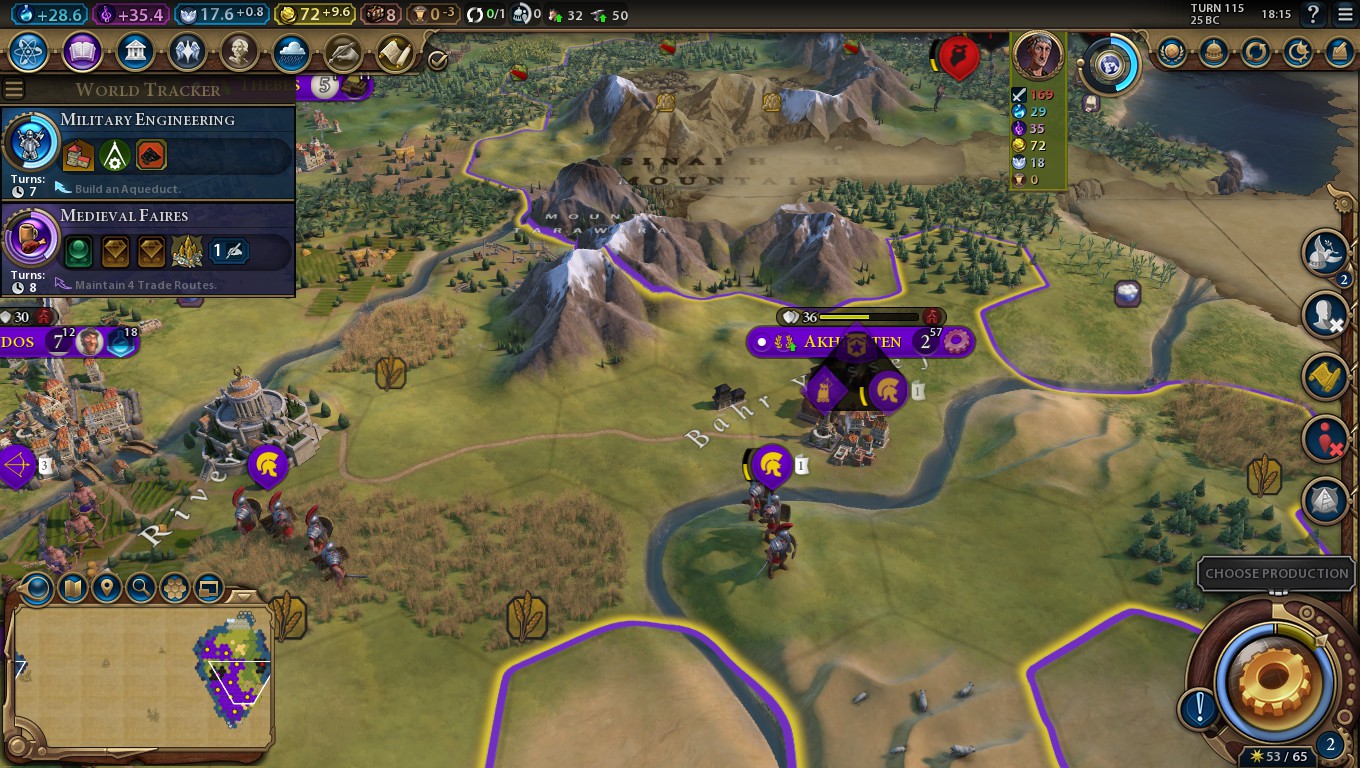
I just captured this city and got a free road out of it!
Rome is a civ that matures quickly – the civ ability, Trajan’s ability, the early-arriving Roman Fort and the Bath UD all help Rome to achieve things that would take longer for most. This maturity helps your empire to support Legion conquests and from there hopefully become the dominant power in the world.
Free roads
Getting immediate free roads when you found or capture a city is a surprisingly useful feature early on. Ancient Roads make all tiles (except river crossings) cost one movement point to enter, which is most effective for areas with lots of woods, rainforests and/or hills. Classical Roads (which you unlock immediately when entering the classical era, such as via the Iron Working technology) also allow units to cross rivers for no additional movement cost. This is great for helping you defend cities against Barbarians, or to send Builders from your more productive cities to newly-founded (or conquered) cities.
Where this ability really gets useful is when you start going on the warpath. Getting a road directly to cities you’ve captured from your capital (so long as the newly-captured city is within 15 land tiles of either your capital or a city connected to it) makes it much easier to bring in reinforcements. That means you can start a Legion rush with a small number of units, and back them up with more later. This also is handy for future wars conducted on the same landmass as your capital.
This bonus fades in effectiveness once railroads become available, but you’d likely have a well-developed road network in your civ by that time anyway.
Trading Posts
Trading Posts are one of the game’s more obscure features. Here’s how they normally work:
- When you send a trade route to a city, after the trade route is completed (in other words, when you have to reassign the Trader) a Trading Post is created in the destination city.
- Trading Posts are “owned” by the civ that created it. Multiple civs can own a Trading Post in the same city. Having a Trading Post from another civ in one of your cities gives no advantage or disadvantage to you, with the one exception of Mongolia – they receive a diplomatic visibility bonus against you if they have at least one trading post in your empire.
- Owning a Trading Post in a city resets the range of trade routes that pass through them. By default, trade routes can travel to a city within 15 tiles by land or 30 by sea. When they pass through a city with a Trading Post from their civ, that range resets.
Screenshots don’t illustrate that well, so here’s a diagram. Cities A, B and C are all on a large landmass. The white hexagons are mountains; traders have to go around them. I can’t directly make a trade route from City A to City B because the distance is one tile too far, but if I had a Trading Post at City C, it would give me enough range.
- All trade routes gain +1 gold per Trading Post in cities they pass through.
Here’s how Rome’s civ ability changes all that.
- All your cities have Trading Posts by default, meaning…
- You can benefit from the trade range increase immediately; any city in your empire that gets a free road from Rome’s civ ability can also send or receive trade routes to any other city in your empire that does.
- Early in the game, you get better gold yields from trading than other civs so long as the trade route passes through at least one of your cities en route.
In a nutshell, you get more gold sooner. The more cities the routes pass through, the more gold you’ll get, which generally means that routes that cross the entire length of your empire will be worth the most money.
The main impact of this unique ability is that you can pretty much ignore international trading in favour of domestic trade thanks to the good immediate gold yields. Considering you’ve got a unique district that gives you extra housing, and you’ve got a fairly expensive unique unit, you’ll want plenty of food and production, and internal trading offers that. Even without the gold advantage, you’d probably want to use most (if not all) of your trade routes internally as Rome anyway, but having the gold allows you to support more units, afford to pay for unit upgrades and things like that.
Summary
- It’s easy to send units over to new or captured cities as they’ll usually have automatic road connections with your capital.
- You can get gold out of internal trading sooner than most civs, and a bit more gold from international trade as well.
Trajan’s Leader Ability:Trajan’s Column
Note: This section (and indeed, this entire guide) assumes an ancient-era start and as such you’ll be getting a free Monument from Trajan’s leader ability.
I’ve only just started the game, and I’ll get the Code of Laws civic in less than half the normal time thanks to the +2 culture bonus of Monuments. This gives me a few extra turns of the Urban Planning policy card, and its +1 production bonus, helping me produce things that little bit faster.
Trajan’s leader ability is simple but effective: Every city you found gets a free Monument. In the first few turns of the game, this will more than double your culture output, and if you can found another city or two, the culture will get you to Political Philosophy quickly (as well as keeping them from flipping into free cities for longer if other cities are imposing loyalty pressure on them). Political Philosophy is an important civic as it gives access to three government options, including Oligarchy. Oligarchy provides +4 strength to your melee units, giving you Legions with 44 strength.
To speed up your progress to Political Philosophy, be sure to pick up as many inspirations along the way as possible:
- Craftsmanship – Improve three tiles
- Foreign Trade – Discover another continent (On duel-sized maps or continents maps, this often isn’t possible, so be prepared to research it completely)
- State Workforce – Build any district (An Encampment is a good idea – it can help you generate an early Great General for a +5 strength and +1 movement point bonus to your Legions)
- Early Empire – Reach a combined total of 6 population in your empire (This is easy once you have a second city)
- Political Philosophy – Meet 3 City-States (A bit map-dependent; if you don’t have this Inspiration by the time you can research this, go ahead and complete it anyway).
You should be able to pick up Political Philosophy around the time you’ll start your Legion wars. It might come a little later, seeing as you need to unlock six civics for it versus just three technologies for Legions, or a bit earlier depending on what Inspirations/Eurekas/city-state bonuses you can get, but they should be reasonably closely-aligned. Don’t forget also to pick up Military Tradition after you’re done with Political Philosophy so you can use flanking and support bonuses for a small additional boost to combat strength.
Being able to get Oligarchy early to support a Legion rush is the main benefit of getting free Monuments, but it also gives your cities a slight head start at border expansion. This ability becomes less effective later in the game when you’re mainly expanding by capturing cities (captured cities don’t get free Monuments) but an extra edge to already-strong early combat is good enough by itself.
Unique Unit:Legion
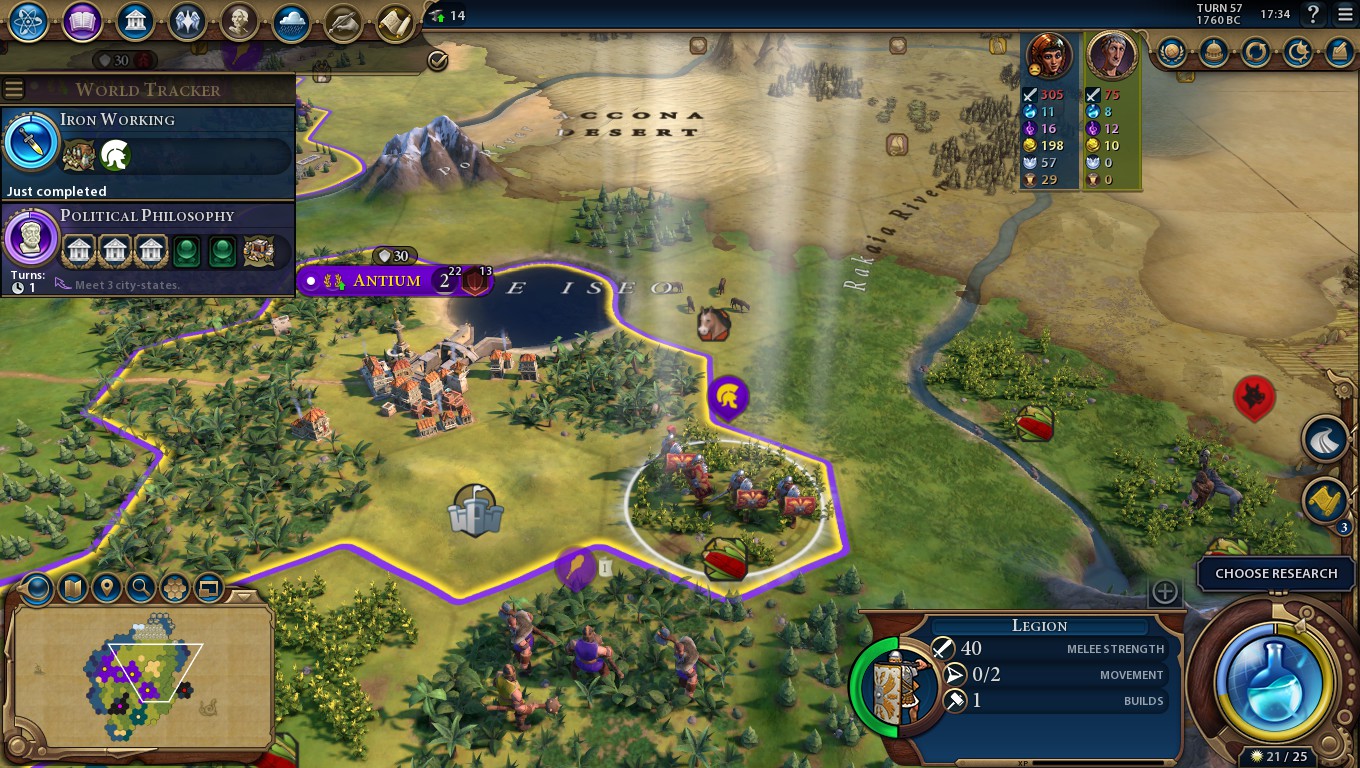
Legions are what you need to to turn Rome from a small state among many to a empire spanning continents. They’re stronger than regular Swordsmen letting them deal more damage and receive less, come with a halved iron, have a charge to build a Roman Fort (which helps defend your homelands as well as newly-conquered lands or even neutral chokepoints) and curiously can even repair damaged improvements and chop down foliage.
Preparation
As with any early military UU, the key is speed; you want Legions at the ready as soon as possible. Start by training a Slinger or Warrior to help with fighting Barbarians. Slingers can deal damage without taking it, but Warriors can be upgraded to Legions later. Killing three Barbarians activates the eureka for Bronze Working, which is crucial to unlock as soon as possible to reveal iron.
Training a Builder and using all but one of its charges allows you to secure iron immediately after Bronze Working is researched, though it is more likely you’ll need to settle an extra city or two first. Even before you have Bronze Working, it’s worthwhile training a Settler anyway to double up on your unit production and culture output.
Warriors cost 150 gold and 10 iron each to upgrade to Legions, so be sure to have a bit of cash ready for when you unlock Iron Working. If you’re fast enough, you can take 2-3 Legions to war without even any siege support, but otherwise taking the Masonry technology for a Battering Ram is a good idea. It won’t take long to research. Masonry also unlocks Ancient Walls; building them triggers the eureka for Engineering, which you’ll need for the Bath UD.
Legions can use their build charge to remove woods or rainforests, helping you rush the production of more units. Use Governor Magnus (the Steward) to boost the production you get from chopping woods/rainforest further. This can more than make up for Legions’ increased production cost.
Your initial attack should be supported by additional Legions to make the process faster (thus allowing you to get more out of the unit before it goes obsolete). Be sure to use the Agoge policy card – Legions are pretty expensive! As every city you capture within trading range of your capital will be automatically linked by road, it’s quite fast to bring new units to the front lines.
Usage
Assuming you’ve not strayed from the task of getting Iron Working and Political Philosophy quickly for Legions and Oligarchy respectively, you should have an enormous advantage over whoever you decide to attack first.
An unprepared neighbour might have nothing stronger than Warriors to defend with – Oligarchy Legions will kill them in just two hits. Getting the Battlecry promotion on top gives you a +31 strength advantage against unpromoted Warriors, which will kill them in one hit most times. Nonetheless, you should still have a mix of promotions between your various Legions so you can adapt to different situations – use the Urban Warfare promotion to help deal with enemy cities.
Don’t worry about pillaging farms and other tile improvements in cities you want to capture (but be wary pillaging districts – they can take ages to rebuild). Pillaging farms will help keep your Legions healed so they can carry on fighting, and you can just repair them afterwards once you have the city.
Aftermath
Once you’ve captured a city, assuming it isn’t completely awful (like a snow city or one without resources in a useless location), it’s time to assimilate it into the empire. You can put your Legions to work repairing any tiles you pillaged, quickly making it productive again. Repairing doesn’t use up the Legion’s build charge.
If the Legion doesn’t perform a different action (like moving or fighting) before repairing a tile improvement, it will heal as well (as if it was set to fortify). That’s a nice time-saver.
Keep in mind that any Legions that build a Roman Fort will lose their ability to repair or remove tile improvements.
Obsoletion
Legions have a pretty wide window of usage, but eventually you’ll need to upgrade them to Musketmen. Interestingly, they don’t lose their ability to build a Roman Fort, nor the ability to repair and remove improvements. As such, there’s little reason not to try and get Gunpowder relatively quickly once you have Engineering for Baths.
Rome can simply carry on with the rest of the game the same way as before – using melee-heavy armies to take over the world. Your strong internal trade routes will provide you with good production and gold to support that.
Unique Improvement:Roman Fort
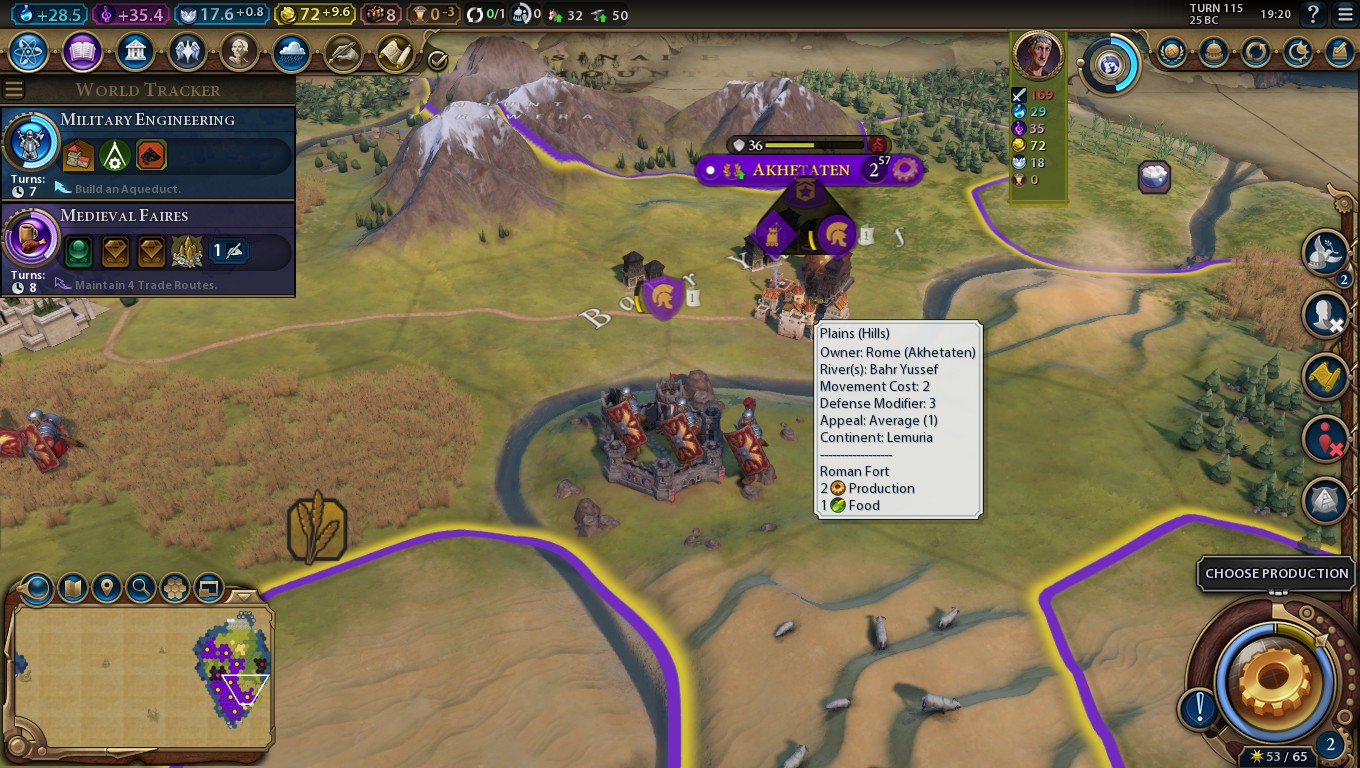
Strictly speaking, the Roman Fort isn’t a unique improvement – it’s mostly identical to a regular Fort and is tied to the Legion UU. Why give it its own section? Because it still has some distinctions that are worth bringing up:
- It’s available two eras earlier than the regular Fort, making it earliest defensive tile improvement aside from China’s Great Wall and the special Alcázar improvement from Grenada’s suzerain bonus. It can be more reliably built where you need it than those two special improvements, however.
- It’s built by a military unit which has other functions as well, meaning you don’t need to spend additional production to make use of it
- Building a Roman Fort does not deplete the Legion’s movement points, allowing them to place a Roman Fort and immediately move afterwards.
- It doesn’t contribute towards the eureka for Ballistics unlike regular Forts.
Despite the fact Roman Forts are basically a free bonus for having Legions, don’t spam them everywhere. Using up a Legion’s build charge stops them being able to repair tile improvements, which is important for cleaning up after you capture a city. You also lose the possibility of clearing foliage for easy bonus production. Instead, use them carefully. These are good examples of places to put a Roman Fort:
- Chokepoints, such as passes between mountains, flat land in the midst of rough terrain or thin strips of land between seas and/or lakes.
- In a line to make open terrain areas more defensible, so long as you have enough Legions for it.
- Near an owned city, in the direction of a civ or city-state which is likely to attack you soon. Putting a couple of Roman Forts together and fortifying units in them can provide an effective obstacle to would-be invaders.
- To quickly protect a valuable but vulnerable military unit, such as a highly-promoted Archer; build the Roman Fort, move the Legion out and move the valuable unit in.
These are not good times or places to build Roman Forts:
- As a last act of a dying Legion, far from home with no backup. You’re just giving whoever takes that land a free fort.
- In a line over open terrain, but with a gap between each one. Mounted units ignore zone-of-control and can just slip through it.
- Somewhere you can’t commit a unit to defend. The +4 defence bonus only works when there’s something actually defending there.
- Just for the sake of it. Don’t waste your charges – Legions without their build charge can’t repair/remove improvements, and lose the opportunity to chop woods or rainforest.
Ultimately, Roman Forts are nice when you need a little extra advantage to hold a point (Oligarchy Legions defending hilltop Roman Forts are particularly tough to kill), but that’s nothing unusual compared to regular forts. Use them when you need them, and don’t waste a build charge putting them up when you don’t need them.
Unique District:Bath
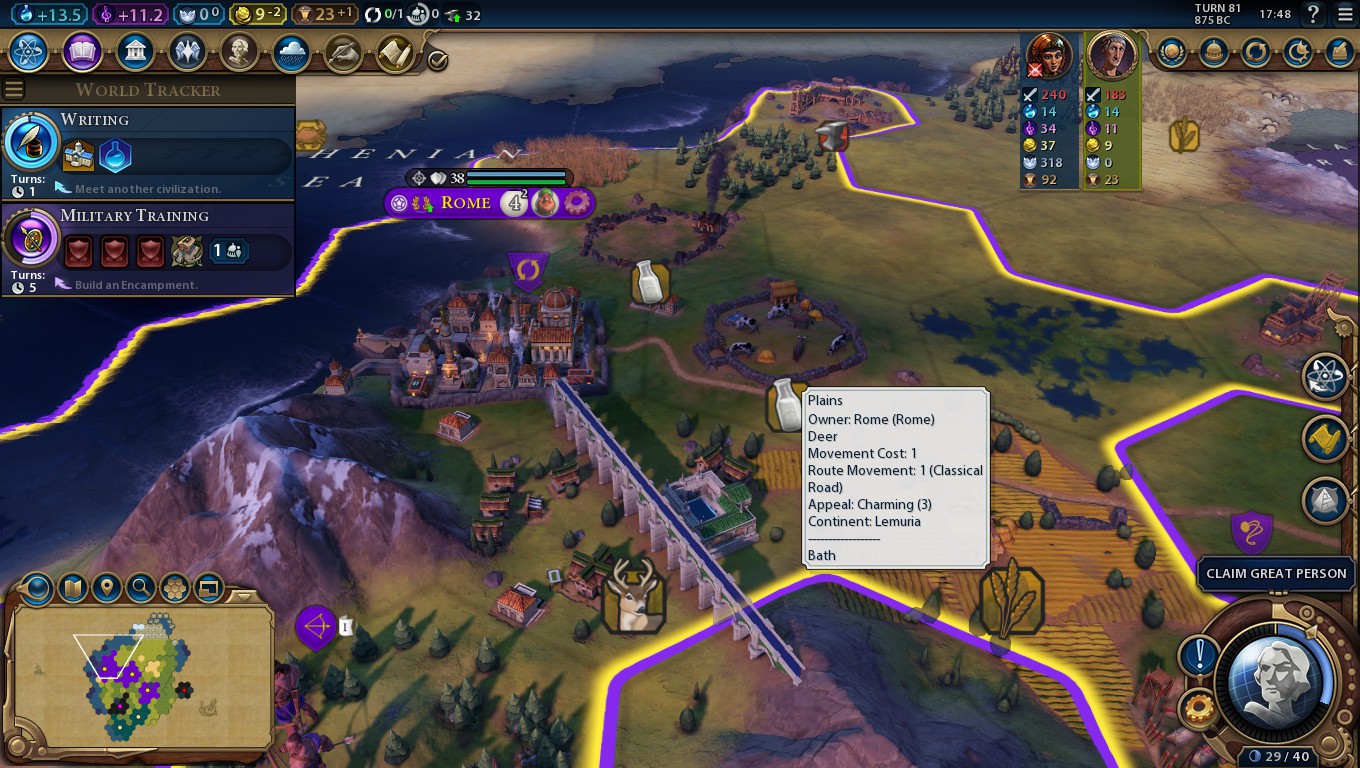
Beyond the training of your early Legion army, you’ll have other things you’ll want to get done in your cities. You’re going to need science so you don’t fall behind in technology, you’ll need gold and amenities to support further wars, and so on. When you’ve got a variety of things to sort out like this, having bigger cities will really help. That’s where the Bath comes in.
To unlock Baths, you’ll need Engineering, which is a little more expensive than Iron Working. You might want to clean up any necessary Builder technologies and Writing first (you don’t generally need a housing boost that early). Masonry lets you build Battering Rams, which go nicely with Legions, as well as Ancient Walls. Building Ancient Walls gives you the eureka for Engineering. You’ll also need the Wheel technology along the way, but that shouldn’t be a problem.
Baths have the same placement requirements as Aqueducts, so any cities you settle should be within a two-tile radius of a river, lake, oasis or mountain. They’re the cheapest district in the game to construct, so even new cities can manage to build them. While you can rush them later on with Military Engineer charges, this is not recommended as they’ll only contribute 20% of the production per charge.
The description for Aqueducts can be a little bit confusing regarding how much housing they offer. This table will show you, assuming no other bonuses to housing, what a city’s total housing capacity will be.
| City Location | Initial Housing | With Aqueduct | With Bath |
| No water access | 2 |
6 |
8 |
| Coastal | 3 |
6 |
8 |
| Fresh water access | 5 |
7 |
9 |
Notice that cities which initially start next to fresh water will gain the least from an Aqueduct or Bath, but still will end up with the most housing overall.
Lots of housing available cheaply means you can more easily manage settling on city spots that aren’t directly adjacent to water. An example of where that situation might arise is if you need to get a spot close to iron for the Iron Working eureka boost.
Every point of housing essentially increases a city’s population limit by 1, so receiving two extra points above normal Baths allows you to have bigger cities than most civs at this stage of the game. Those two extra points of population require one amenity – something the district neatly provides you with. All you need is a bit of food and you can have an empire with many large cities. Every three population points allows a city to build one more speciality district, and the more speciality districts a city has, the better food or production yields you’ll get from domestic trade with that city.
Ultimately, Baths take a district of varying utility and make it a more consistently effective way to make your cities bigger. A vast empire with conquered cities that can be repaired to their former glory quickly with Legions, become rich from internal trading, and grow to a large size thanks to the cheaply-available housing and amenity from Baths is one to be feared.
Administration – Government and Policy Cards
Note that the Administration sections strictly cover the options that have particularly good synergy with the civ’s uniques. These are not necessarily the best choices, but rather options you should consider more than usual if playing this civ relative to others.
Government
Tier One
Oligarchy is the obvious choice – a +4 strength bonus for Legions is quite considerable!
Complement it with the Warlord’s Throne so your early conquests boost the production in all your cities.
Tier Two
Merchant Republic and Monarchy are both good choices. For the former, the gold boost is pretty minor, but the district production bonus is good, particularly considering your Bath-enhanced cities can support more districts than the typical cities of other civs. For Monarchy, the high number of wildcards makes it versatile.
Out of the tier two government buildings, the Intelligence Agency will probably be the most useful – you can use that extra Spy to steal more eurekas to keep your military up to date, or use it for the diplomatic visibility bonus to help your own units become stronger.
Tier Three
Fascism offers plenty of military bonuses to get you through the end of the game.
Complement it with the War Department for extra health for every kill your units make.
Tier Four
Corporate Libertarianism works well if you’re carrying on the domination game.
Policy Cards
Ancient Era
Agoge (Military, requires Craftsmanship) – Legions are costly to train, so grab this policy card to make it much more manageable. This is particularly effective if you’re chopping down trees to rush Legion production.
Caravansaries (Economic, requires Foreign Trade) – Builds on the gold from trading you already get.
&nbsnbsp;
Conscription (Military, requires State Workforce) – This will help you support your Legion army.
Limitanei (Military, requires Early Empire) – For all the strength Legions have, they are one of the slower early rushing units, which can make loyalty more of an issue than it would be for civs like Scythia. This policy card will help you hold onto initial conquests for longer, giving you more time to move onto your next target.
Classical Era
Equestrian Orders (Military, requires Military Training) – An extra supply of iron to support Legion training.
Raid (Military, requires Military Training) – The build charge Legions have allow them to repair pillaged tile improvements, meaning you can pillage with lesser consequence relative to most other civs. Use this policy card to increase those pillage yields by 50%.
Medieval Era
Professional Army (Military, requires Mercenaries) – You can simply keep upgrading your Legions and sending them off to war for the rest of the game. This policy card helps you to save money when doing so.
Retinues (Military, requires Mercenaries) – Upgrading Legions to Musketmen costs a lot of nitre. Halving that cost frees up more for Bombards.
Renaissance Era
Drill Manuals (Military, requires Mercantilism) – Helps provide more nitre for upgrading Legions.
Triangular Trade (Economic, requires Mercantilism) – Get even more gold out of your domestic trade.
Administration – Age Bonuses and World Congress
Age Bonuses
Only bonuses with notable synergy with the civ’s uniques are covered here.
Isolationism (Dark Age, Classical to Industrial eras) – Conquering rather than founding cities? Put your trading post bonuses to good use and enjoy some powerful internal trade routes.
Twilight Valour (Dark Age, Classical to Renaissance eras) – Combined with the Oligarchy government, Legions will attack with a massive 49 strength – more than a Knight! The downside is that they’ll no longer be able to heal outside friendly terrain.
Reform the Coinage (Dedication, Renaissance to Modern eras) – Rome has a slight (though not huge) incentive to create plenty of trade routes, so you can squeeze a bit more era score via this dedication.
Reform the Coinage (Golden Age, Renaissance to Modern eras) – Rome’s civ ability allows you to trade very long distances with ease, but that does leave those routes vulnerable to pillagers. This Golden Age dedication removes that risk entirely – at least until the end of that game era.
World Congress
How you should vote in the World Congress will often be specific to your game – if you have a strong rival, for example, it might be better to vote to hurt them than to help yourself. Furthermore, there may be general bonuses to your chosen victory route or gameplay which are more relevant than ones that have stronger synergy with civ-specific bonuses. Otherwise, here’s a list of key votes that have high relevance for this civ relative to other civs.
Deforestation Treaty – Effect A (Clearing features of the chosen type yields gold equal to the production and/or food) on woods or rainforest.
If you have any build charges from Legions remaining, they can go further when chopping down foliage with this bonus.
Mercenary Companies – Effect B (Producing, or purchasing military units using the chosen currency type, is -50% of the cost until the next World Congress)
Enhances the effect of rushing units by chopping down woods/rainforest with Legion charges.
Military Advisory – Effect A (Units of the chosen land promotion class gain +5 strength) on melee infantry units.
Makes Legions or their upgraded counterparts more effective.
Trade Policy – Effect A (Trade routes sent to the chosen player provide +4 gold to the sender. The chosen player receives +1 trade route capacity) on yourself or a civ you trade a lot with.
Get a little more gold out of your trading posts.
Urban Development Treaty – Effect B (No buildings can be created in this district) on city centres.
You’ll receive Monuments for free when settling cities, but other civs will be prevented from building them at all.
Administration – Pantheons, Religion and City-States
Pantheons
Fertility Rites – A free Builder is very helpful for early development, while the growth bonus helps you fill the housing capacity of Baths sooner.
God of the Forge – Legions are expensive. This combined with Agoge helps minimise that problem.
Religious Settlements – The free Settler is excellent for early development and securing iron resources early on.
Religious Beliefs
You can have one founder, one follower, one enhancer and one worship belief.
Defender of the Faith (Enhancer) – Combined with a hilltop Roman Fort, you can safeguard your cities with a minimal defence while the rest of your army is elsewhere. While the offensive counterpart of this belief, Crusade, is powerful, it’s a bit harder to use as Rome due to the need to acquire religious units and spread the faith in the cities of other civs before invading them.
Feed the World (Follower) – While you may only have Holy Sites in captured cities, extra food will still be useful to grow your cities to meet the housing offered by Baths.
Gurdwara (Worship) – Similarly offers extra food to help hit the housing cap.
City-States
Akkad (Militaristic) – Who needs Battering Rams when you’re suzerain of Akkad? That saves production, and cuts out the need to research Masonry.
Hattusa (Scientific) – Ensures you can get iron for Legions, and saves a little time getting access to nitre once you have the Gunpowder technology.
Hunza (Trade) – Trading posts allow trade routes to travel further, and therefore get more gold with this city-state’s suzerain bonus.
Mogadishu (Trade) – Even land-based empires will usually have some trade routes that enter the sea. Being immune to those routes being pillaged saves you having to build a navy to repel Barbarian pirates.
Mitla (Scientific) – Faster-growing cities can fill up Bath housing sooner.
Mohenjo-Daro (Cultural) – The bonus can be useful to help cities grow in the period before they have a Bath built. Once your cities all have Baths built (or have direct freshwater access anyway) then you don’t need to worry about losing suzerain status.
Singapore (Industrial) – Exploit your trading advantages for extra production.
Wolin (Militaristic) – Secure Great Generals without needing to invest in Encampments.
Administration – Wonders and Great People
Wonders
Hanging Gardens (Ancient era, Irrigation technology) – One to capture rather than build. The growth bonus helps your cities to fill the extra housing offered by Baths faster.
Temple of Artemis (Ancient era, Archery technology) – You may not be able to build this wonder early on, but you may well be able to capture it off someone else. A city with a Bath and the Temple of Artemis can grow to a particularly huge size early in the game.
Colosseum (Classical era, Games and Recreation civic) – Position this somewhere in range of a few good city spots, and enjoy +4 culture for every city you found in range of it. The amenity bonuses will mean those new cities will have no downsides, and the extra Trading Posts and roads those cities create will be very helpful.
Colossus (Classical era, Shipbuilding technology) – An extra trade route means more gold, food and production.
Terracotta Army (Classical era, Construction technology) – While your Legions are off at war, building this at home will let you upgrade all of them. Highly-promoted Oligarchy Legions are even more of a nightmare for your enemies to face. The Great General Point is also useful – if you can get a classical-era Great General, your Legions will be even stronger still.
Angkor Wat (Medieval era, Medieval Faires civic) – Build upon the advantage Baths offer you with extra population and housing in every city.
University of Sankore (Medieval era, Education technology) – Squeeze science out of your internal trade routes. Free trading posts mean even distant cities can get a bit of science here.
Great Zimbabwe (Renaissance era, Banking technology) – Put this on one end of your empire in a bonus resource-heavy city, and send trade routes to the other end of your empire for enormous gold yields.
Torre de Belém (Renaissance era, Mercantilism civic) – Can help create more powerful international trade routes.
Great People
Remember that these are only the ones that have particular synergy with Roman uniques, not necessarily the most effective options.
Classical Era
&nbsnbsp;
Zhang Qian (Great Merchant) – +1 trade route capacity.
Zhang Heng (Great Scientist) – Can help you unlock Baths sooner.
Medieval Era
El Cid (Great General) – Although El Cid doesn’t provide an area-of-effect bonus to Legions (you need Boudica, Hannibal Barca or Sun Tzu for that), retiring him on a Legion gives you a unit with 50 strength! Add Oligarchy on top, and you’ve got a unit that’s on a par with a Musketman.
Ibn Fadlan (Great Merchant) – +1 trade route.
Irene of Athens (Great Merchant) – +1 trade route capacity.
Marco Polo (Great Merchant) – +1 trade route capacity.
Zheng He (Great Admiral) – +1 trade route capacity.
Renaissance Era
Raja Todar Mal (Great Merchant) – Makes internal trading even better for gold.
Modern Era
John Rockefeller (Great Merchant) – Can help you get even more gold out of trade.
Atomic Era
Melitta Bentz (Great Merchant) – +1 trade route capacity.
Jane Drew (Great Engineer) – Offers Bath-esque housing and amenities, letting you hold off from dedicating production or tiles towards a Neighbourhood or Entertainment Complex.
John Roebling (Great Engineer) – Also offers Bath-esque housing and amenities.
Counter-Strategies
Survive Rome’s classical-era onslaught and they’ll still have a pretty strong empire, but their advantages will fade letting you strike back.
Civilization Ability:All Roads Lead to Rome
Rome doesn’t have much of an incentive to trade externally early on considering they can get gold from internal trading more easily, so look between Roman cities for good plunder targets. Fast-moving units will be the most effective at this task. Later on, Rome will only get the most out of that bonus if they send Traders on particularly long routes – which again, is vulnerable to pillaging.
As for Rome’s free roads, remember that you can pillage roads in neutral territory without needing to be at war. Do so and you can slow down their invasion of another civ.
Trajan’s Leader Ability:Trajan’s Column
Free Monuments in Roman cities will get them quickly through early civics, (and gives them a minor edge in resisting loyalty pressure) but will fade in effectiveness later in the game.
If you’re invading Rome, it’s nice to know that the cities you capture will come with Monuments you can quickly repair and put to use outputting culture. Otherwise, it’s generally more important to consider the threat of Legions than the power of this ability.
Trajan’s Agenda:Optimus Princeps
Trajan wants lots of cities and land. If anyone has a high number relative to the average civ in the game, he’ll like them. If anyone has fewer cities, he’ll dislike them. He’ll never have the Expansionist hidden agenda as it overlaps with his main agenda.
If you want to befriend Trajan, you simply need to settle extensively (conquering also works, but beware of warmonger penalties). Keep an eye on your amenities – having lots of cities can be a strain on them.
Unique Unit:Legion
Legions require iron to be trained, so if Rome can’t secure any, they’ll lack a very powerful unique unit. Quickly researching Bronze Working may buy you time to grab iron tiles before Rome can, though be sure you’re not hurting your other early objectives in the process.
If you can’t stop Legions being trained, a good defensive option is either Horsemen or Swordsmen of your own. They both require resources, but Horsemen should be a little more manageable considering horses are revealed earlier in the game and are cheaper. Garrisoning your cities with Archers is also a good idea.
Rome will probably have a slight head start in the race to classical-era units, so delay tactics are important. Planting units on defensive terrain means they should be able to survive a hit or two, before retreating and being replaced with another. The Agoge or Manoeuvre policy cards will help you build pre-medieval units faster and will be pretty much compulsory. Legions are pretty expensive so even if you’re losing units faster than Rome, there’s a good chance you’ll be able to survive until you can get a unit that can more reliably face them.
Coursers and Knights can stand up to the strength of Oligarchy Legions, and can retreat quickly in case they take heavy damage. You’ll need horses for Coursers, or iron for Knights. Alternatively, Crossbowmen perform well (though be sure to position them on defensive terrain).
Unique Improvement:Roman Fort
An Oligarchy Legion defending on a Roman Fort seems horrible to deal with, but simply placing an Archer on a hill two tiles away allows you to shoot at it, while having enough time to retreat if the Legion wants to retaliate.
When it comes to Roman Forts in general, make use of those in neutral territory if possible, but otherwise pillage any others left empty. Horsemen make good pillagers as they avoid zone-of-control and have enough strength to withstand a couple of hits from Legions.
Note that unlike other unique improvements, Roman Forts are kept if you take over the tile they’re in. You can then use them exactly the same way you’d use regular forts.
Unique District:Bath
Because Baths have to go next to the city centre, they can be quite tricky to pillage unless you’re actively attacking the city. On the other hand, because they have to go next to the city centre, it forces Rome into specific city placements. It’s not a good idea to settle cities to deliberately prevent Rome from getting Bath spots early on – being on the receiving end of a Legion invasion isn’t worth it – but that can work somewhat later on.
Hope you enjoy the Guide about Sid Meier’s Civilization VI – Zigzagzigal’s Guides – Rome (GS), if you think we should add extra information or forget something, please let us know via comment below, and we will do our best to fix or update as soon as possible!
- All Sid Meier's Civilization VI Posts List



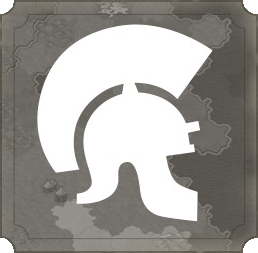

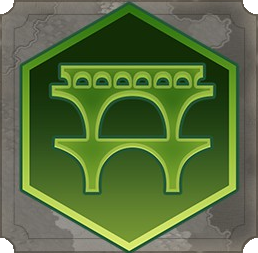
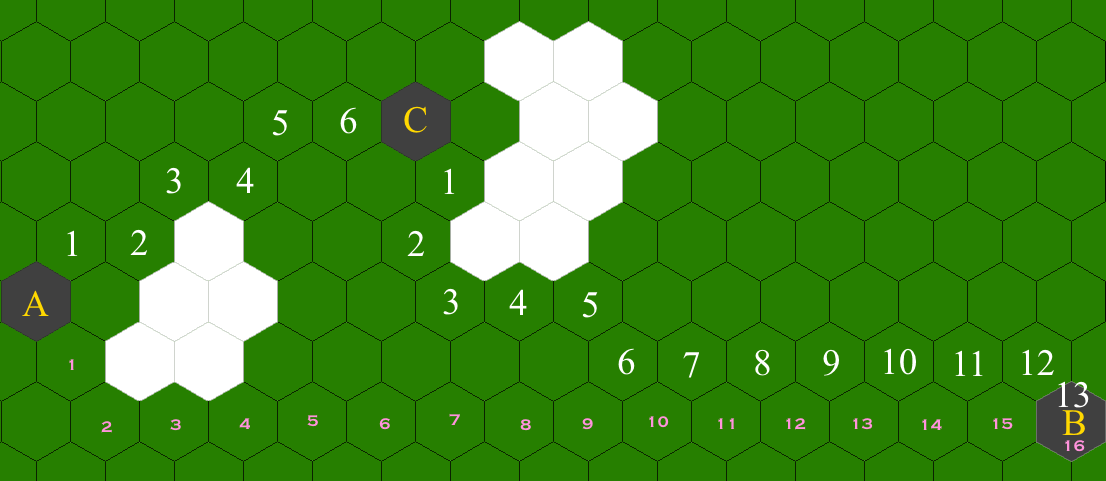
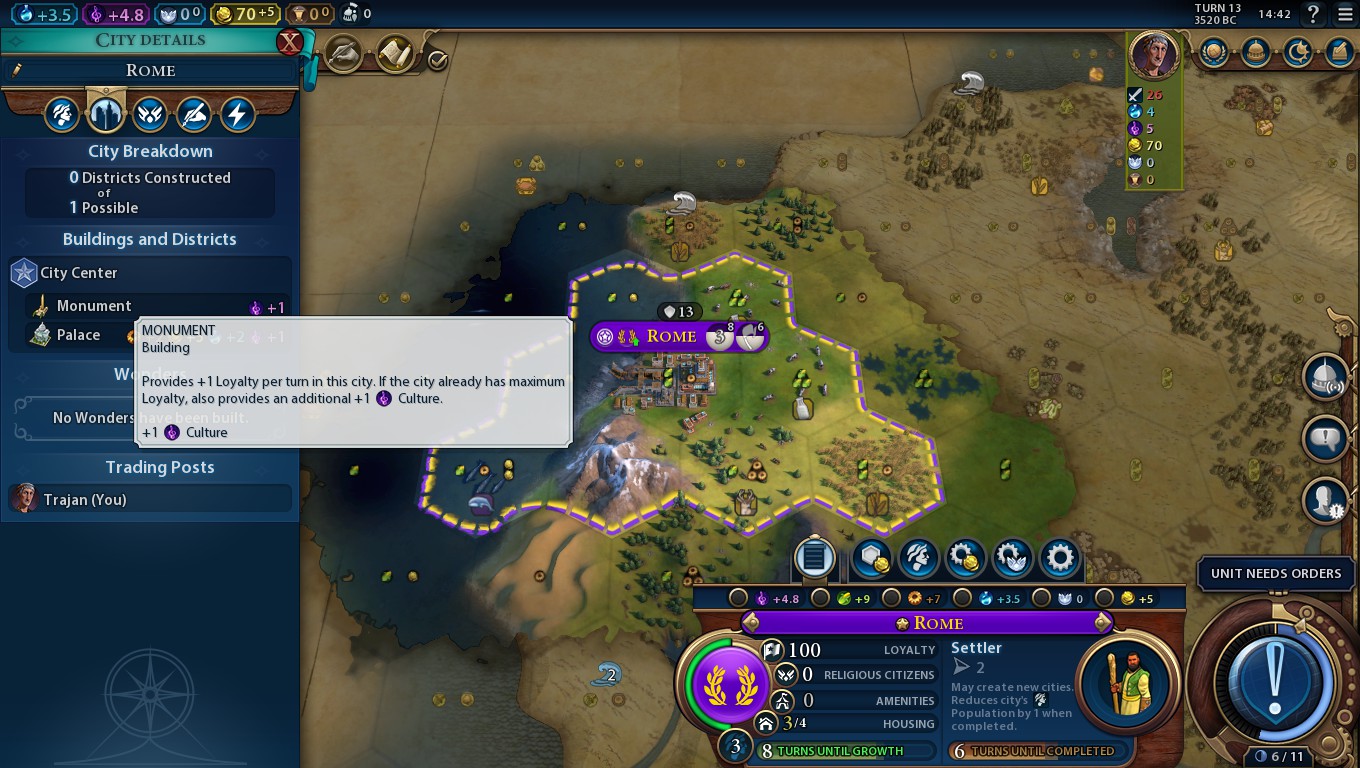
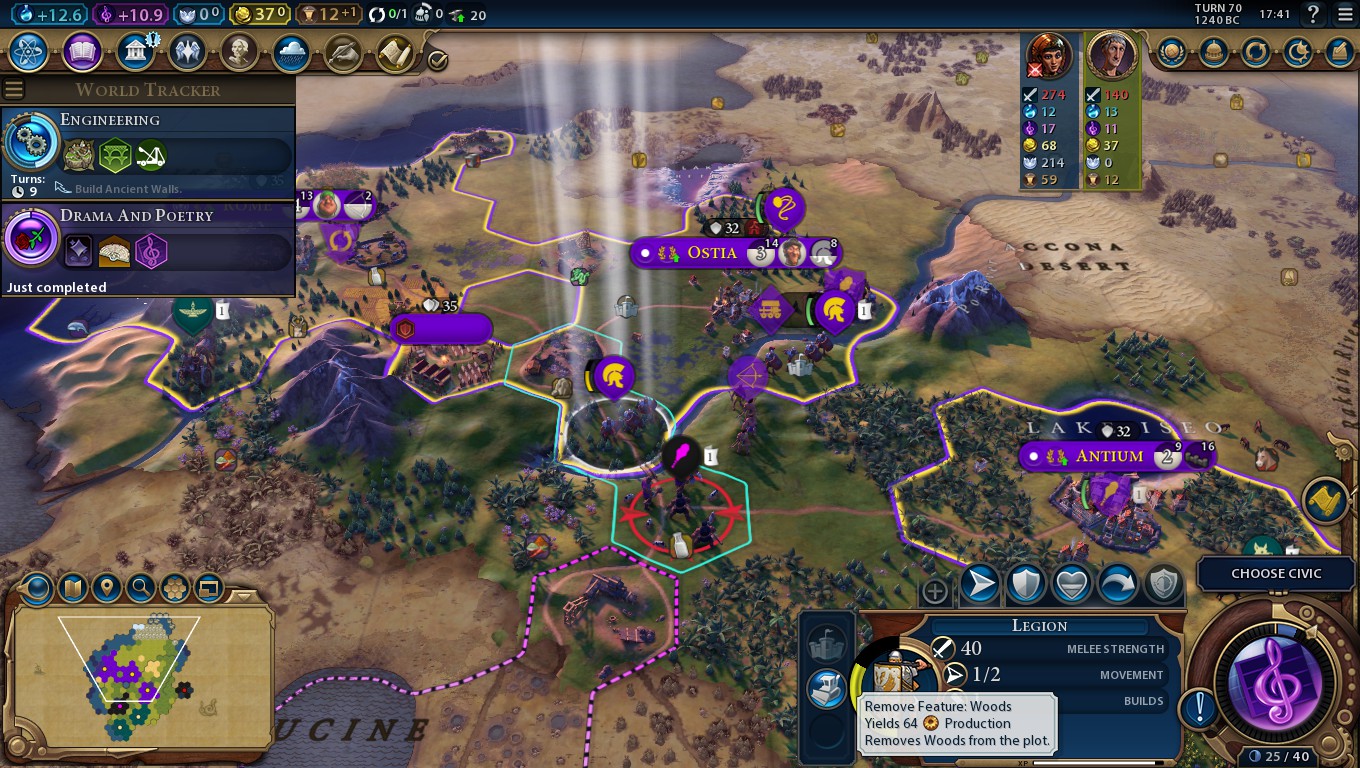
Leave a Reply